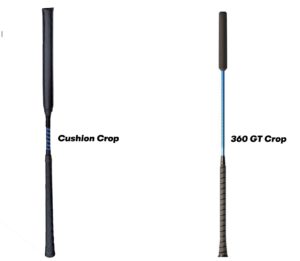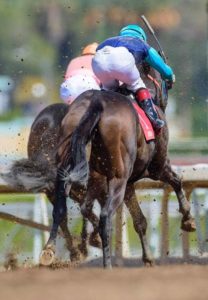When the current traditional cushion riding crop was first introduced in 2008, jockey Ramón Dominguez was riding regularly at Delaware Park. Although the cushion crop was supposed to be the new and improved version of a riding crop, Dominguez soon began to notice aspects of the new crop that could be improved even further. Following his retirement and induction into the Hall of Fame, Dominguez began focusing on crafting the ideal riding crop. He formally introduced the 360 Gentle Touch Crop earlier this year. The PHRA recently had the opportunity to sit down and talk with Dominquez about this new product that he developed for the racing industry.
In crafting the 360 Gentle Touch Crop, Dominguez focused on making a number of changes to the cushion crop, which has grown in popularity over the past decade. The cushion crop is constructed by sewing two pieces of leather together to form a rectangular shaped “popper”, or contact end. Although the cushioned padding of the popper provided a gentler alternative to whips of old, the uncushioned edges and stitching were hard and not as comfortable on a horse’s hide.

“As a jockey, you really have no control as to how the popper is positioned, whether it’s on the flat side or if it’s on the edge. If it is on the edge, clearly the impact can be greater than the flat side and can possibly hurt the horse,” Dominguez explained. “That was really the one key factor that brought me to start thinking about how we could minimize the edges.”
In addition to the problem posed by the uncushioned edges of the crop, Dominguez also noticed that the crops would sometimes break down from weather and chemical elements. The crop would absorb water when it rained and completely change the way it was handled.
“I had the idea to maybe do something with a cylindrical shape because obviously, a cylinder doesn’t have edges,” said Dominguez. “The second thing was how to make it waterproof. I first experimented with a bicycle inner tube. That was my first prototype. I got a patent in 2011 and that idea continued to evolve to where we now have a different product.”
With the protection of the horse in mind, many different materials were experimented and tested for different compression factors, while also maintaining the durability and resistance that was needed to withstand usage. The result was a specially created shock absorbing foam that is resistant to both water and chemicals.
The foam popper creates a very loud sound when it comes in contact with the horse, and the audible impact helps contribute to encouraging the horse. Because of this, jockeys don’t have to use as much force as they would with a cushion crop. The horse still feels the soft foam of the popper as a means of encouragement without the risk of being struck by a hard edge or seam. The 360 Gentle Touch has even been compared and tested with the traditional cushion crop, with results showing that the 360 GT is the gentlest riding crop the industry has ever seen.
The cylindrical popper of the 360 GT crop is the only component that differs from the traditional cushion crop. The 360 GT acts and feels like traditional crop, so it requires no adaptation or change on the part of the jockey.

Following a limited release of the 360 GT’s in April of this year, the jockey colony at Keeneland quickly adopted the crop. In a testament to its effectiveness, the crop was handled in Grade 1 winning rides its very first weekend of use. Any remaining doubts that may have existed in the racing community about the crop’s performance were put to rest after it was carried to victory in all three legs of this year’s Triple Crown.
Ramón is currently putting the finishing touches on the final version of the 360 GT before it’s officially put on the market.
“My ultimate goal is for people to learn about how awesome of an alternative this is because it really is the evolution of the riding crop,” he explained, “I want to be able to reach other equestrian disciplines throughout the world as well, because so many other disciplines use basically the same type of riding crop. I feel that we’ll be able to make a very positive impact in the equine and equestrian world.”
With racing as a whole being under a microscope of late, the conversation around the use of riding crops has been reignited as well. Dominguez stressed two main factors in terms of riding crop importance for a rider: safety and encouragement. Other than the obvious safety benefits of using the crop to help a horse maintain a straight course, Ramón explained how sometimes horse and rider can find themselves in a situation where they are in close quarters, typically at the end of a race, and need to go through an opening to get in the clear.
“If you have a young horse, and the horse is hesitant to go through the opening, the encouragement with the riding crop would be the right signal, or the needed signal, for the horse to get the assurance that it’s okay to go through the opening,” Dominguez explained. “That way, not only can the horse maximize its potential of winning or placing well, it also maintains safety because oftentimes a horse will get halfway through an opening before getting hesitant and bolting to the side where they can clip heels.”
Ramón provided another example, noting that certain horses can be hesitant to cross over puddles on the track while it’s raining. A tap on the shoulder or hindquarters with the crop is enough reassurance to let the horse know that it’s okay to go through the puddle.
Dominguez stressed that the encouragement aspect of the riding crop is also extremely important.
“It would be awesome if every horse was a push-button horse that came out of the starting gate and all the jockey needed to do was just try and control their speed, but unfortunately not all horses are like that,” he said. “A lot of horses, and even some great horses that I had the opportunity to ride, were ‘I’m gonna do as little as I have to’ or ‘maybe if I feel like doing it, I’ll do it’ type of horses. For horses like that, getting the encouragement from the riding crop shows that it’s time for them to go and it maximizes their chances of performing. The crop can help put them in a spot where they can give a good run and do the best that they can do. Without the riding crop, those horses would never be able to show their true ability, and at the end of the day, it’s not a level playing field for the game, the sport, and the fans.”
As mentioned before, Dominguez is in the final phases of officially putting the 360 GT riding crop on the market. In about two weeks, his company’s website (rydersup.com) will launch.
We are looking forward to the launch and hope to soon see the 360 GT riding crop on racing circuits all across Pennsylvania.











